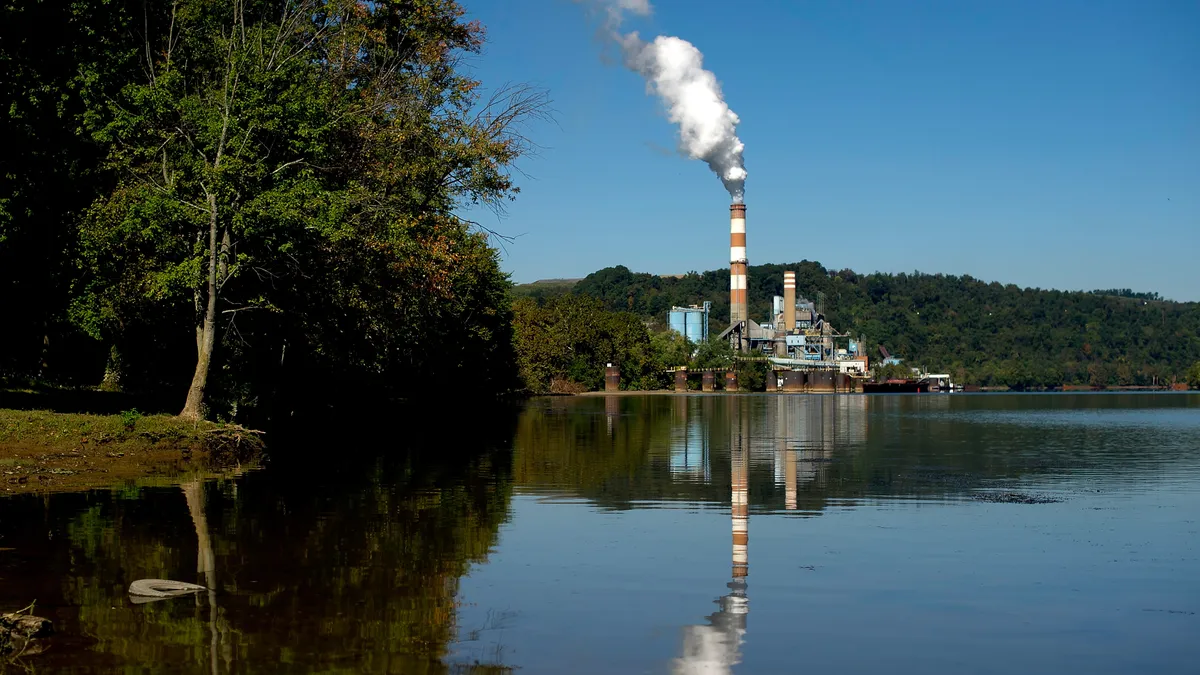Dive Brief:
-
After two-and-a-half years of effort led by Democratic Gov. Tom Wolf, regulations were published online April 22 that enable Pennsylvania to be the 12th state to join the Northeast and Mid-Atlantic program that caps carbon dioxide emissions from participating coal- and natural gas-fired power plants.
-
As part of the Regional Greenhouse Gas Initiative, Pennsylvania will be required to make annual emissions reductions of 3%. The ceiling on the state's power plant emissions is 78 million tons this year, equal to about 80% of the total allowances RGGI auctioned in 2021.
-
Proponents of RGGI membership say it will accelerate the state’s transition away from coal and natural gas to clean energy, but Republican lawmakers and their allies are continuing their attempts to block the state’s participation. Pennsylvania's upcoming gubernatorial election is likely to decide the fate of its participation in the next four years.
Dive Insight:
Pennsylvania’s participation in RGGI’s quarterly auctions of carbon allowances won’t begin until the third quarter of this year because of roadblocks by the Republican legislature and the refusal of the state agency charged with publishing the rules to do so last year.
“Publication of the rules is undoubtedly a historic moment for Pennsylvania,” Robert Routh, Clean Air Council public policy and regulatory counsel, said of the enabling regulation. “This is the most significant policy step Pennsylvania has taken to combat climate change in its history.”
The regional market mandates that power plants buy approximately one ton of allowances equal to each ton of CO2 emitted.
In addition, the Department of Environmental Protection is required to develop a plan on how to spend the auction proceeds, which will flow to the state’s Clean Air Fund. That fund is focused on energy efficiency, renewables and other air pollution reduction practices, and going forward, an emphasis on racial equity. Pennsylvania’s share of proceeds from the quarterly auction of carbon allowances is expected to contribute hundreds of millions of dollars annually to the fund.
“We are excited we got to this point and are looking forward to working with the Department of Environmental Protection on the best way to invest this money, including to help improve the health of communities historically overburdened,” said Tom Schuster, clean energy program director for the Sierra Club Pennsylvania Chapter.
RGGI advocates said delaying participation has cost the state hundreds of millions of dollars that would have been reaped from the first quarter 2022 auction. Other benefits were also delayed.
However, opponents, including the Pennsylvania Chamber of Business and Industry, continue to object to the state’s entry into the regional carbon trading market.
“The final rulemaking does not address the Chamber’s concerns regarding transparency of costs, addressing leakage and protecting the state’s industrial base,” Chamber spokesperson Sam Denisco said in a statement. He declined to comment on whether the Chamber will sue to stop the effort.
Owners of fossil-fired power plants will have to buy hundreds of millions of dollars of carbon allowances. Pennsylvania's electricity sector is by far the largest emitter of greenhouse gases in the RGGI market.
The Pennsylvania Department of Environmental Protection estimates that participation in the regional trading market will slash the state's power plant carbon pollution by up to 225 million tons by 2030, with a significant lowering of nitrogen oxides, sulfur dioxide, and particulate matter emissions, too. The DEP also estimates that RGGI auction proceeds will grow Pennsylvania’s Gross State Product by nearly $2 billion, with a net increase of 30,000 jobs by the end of this decade.
According to the Sierra Club, however, the state projections are “an under-estimate of what we’ll actually see because their allowance prices are lower than we have seen in recent years,” with DEP projections at $2-$3 per ton of allowance, Schuster said. The last auction sale price was $13.50 per ton.
Pennsylvania is the heavyweight
Of the Eastern and Mid-Atlantic states participating in RGGI, Pennsylvania is the largest generator of electricity, and exports more power. Other members are Connecticut, Delaware, Maine, Maryland, Massachusetts, New Hampshire, New Jersey, New York, Rhode Island, Vermont and Virginia.
For many years, coal was the dominant power plant fuel in Pennsylvania, but its share of the state’s generation mix has been steadily dropping because burning the resource has become largely uneconomic in the last several years, aside from a recent uptick caused by the surge in natural gas prices.
Pennsylvania’s gas-fired plants produced 52% of its electricity, nuclear plants 33%, coal 10% and 4% came from renewables and garbage incineration in 2020, EIA data reveal.
In 2021, state power plants emitted 85.3 million tons of carbon dioxide, the highest level since 2016, reported the Pittsburgh Post-Gazette using U.S. Environmental Protection Agency emission figures. That’s a 9.6% increase from 2020 and largely associated with the surge in coal-fired generation.
The largest of the state’s five remaining coal plants, Keystone, emitted almost 7.95 million tons, according to the U.S Environmental Protection Agency. State power plants are required to meet half their allowance requirements by the Department of the Environment by next March and 100% in March 2024.
How Pennsylvania’s participation in the third quarter auction of allowances will affect RGGI’s overall allowance prices, the heart of the program, is unknown, with expectations from clean energy advocates that it will push prices down. But the 78 million cap level aims to keep the state’s entry from driving prices too low or too high, the Sierra Club’s Schuster said.
With Gov. Wolf's term ending in November, whichever parties' candidate wins the gubernatorial race may decide whether the state continues to participate in RGGI. Wolf is term-limited and must leave office in January 2023.
Correction: A previous version of this story had an incorrect affiliation for Robert Routh. He works for the Clean Air Council.














